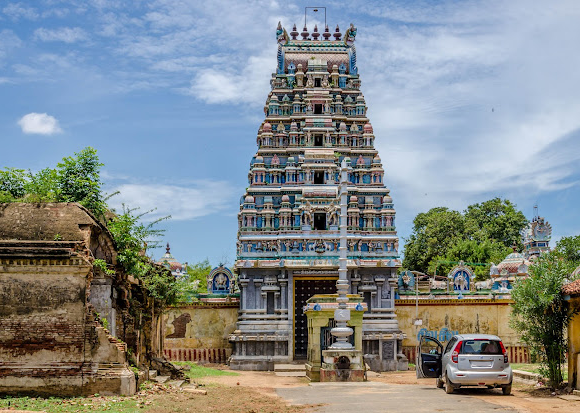Origin/History :-
This temple is associated with the hymns sung by Thirugnanasambandar in praise of Lord Shiva, suggesting that its original structure may have existed before the 7th century. Over time, the temple was reconstructed in stone and extended by the Vijayanagara dynasty. It has been maintained by the Nattukottai Nagarathars.
- The inscriptions found in this temple date back to the reign of Rajaraja Chozha. According to these inscriptions, the area was referred to as Rajendra Chozha Valanattu and Aruvala Kootrathu Nellika, with Lord Shiva known as Nellika Udayar or Amlakeswarar.
- An inscription from the period of Rajaraja Chozha (II or III) mentions the endowment for burning a perpetual lamp, for which lands were donated to the temple.
- Rajaraja III’s 21st reign year inscription documents the endowment of a lamp at Kulachirai Madam/Mutt, with a land gift in return for 25 Kuli as irayili given to “Thirugnanasambandar Gugai,” possibly a monastery.
- Another inscription from Rajaraja III’s 20th reign year records a gift of 68 Kuli of land to establish a nandavanam (garden) by Maraignanasambandan and Ivazhithervithakar, associated with “Thirugnanasambandar Gugai.”
- A damaged inscription from the same reign year also notes a gift of land for Naivedyam to Lord Ilaya Pillaiyar (Murugan) by Maraignanasambandan.
- Additionally, Rajaraja III’s 9th (8 + 1) reign year inscription records the donation of 400 kasus for burning a Sandhi (Iravanavira sandi) by Andavan Selakalvan of Arur, received by Sivanan Thirunellikavudayan, alias Virasola Bhattan.
- An inscription from Kulothunga Chozha III’s 7th reign year mentions an endowment for burning a perpetual lamp, with 160 kasus gifted by Tirunattamadi Atkondanayakan, alias Ethirilisola Idaiyalanattukon, the headman of Kundralur.
- Other fragments and damaged inscriptions from the Chozha period indicate additional land and monetary gifts made for the purpose of burning lamps in the temple.
- Sthalapuranam 1 :
The five sacred trees of Devaloka Parijatham, Karpagam, Mandaram, Harichandanam, and Santhanam became arrogant due to their ability to fulfil the wishes of devotees. Their pride led them to disrespect Sage Durvasa, who, in anger, cursed them to be born as nelli (gooseberry) trees, known for their sour fruits. Once on Earth, the trees prayed to the Lord, seeking relief from their curse, and were eventually restored to their heavenly forms. However, Lord Shiva chose to remain behind as a Swambhu murti, teaching the world about the virtues of nelli. He also blessed Sage Durvasa to overcome his anger at this sacred site. In Sanskrit, nelli is referred to as Amla, and thus the Lord here is also known as Amlavanaveswar.
- Sthalapuranam 2 :
A devotee of Shiva once ventured into the forest and observed that animals and birds coexist harmoniously. Even the Devas would visit the area daily. The devotee reported his findings to the Chola king, who was greatly pleased. In response, he cleared the forest and established a town along with this temple, adopting the name Amlanesan.
King Uttama Chola and his queen, Padmai, were childless. During one visit to the temple, a young girl approached and sat on the queen's lap. A voice then instructed them to raise the girl as their own. They obeyed, naming her Mangalanayagi, who was none other than Parvati. When she reached marriageable age, she wed Lord Shiva here on the first day of the Tamil month of Avani (August-September).
- Sthalapuranam 3 :
This temple has a unique connection with the Ramayana. Kakasura, an asura in the form of a crow, troubled Sita during her imprisonment in Lanka. After Lord Rama invaded Lanka, he aimed an arrow at the crow. To escape, the crow sought refuge in various places, eventually arriving here to pray for the protection of Lord Shiva. The Lord intervened and requested Rama to pardon the crow.
Additionally, Sage Susanam had killed his father in a fit of anger and was suffering from brahmahathi dosham as a result. Upon hearing the story of Kakasura, he visited Tirunellikkaa, bathed in the Teertham, and fed a crow. By doing this, he was liberated from his curse.
